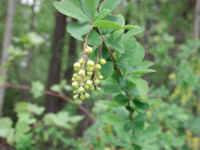 Common Barberry (Berberis vulgaris L.)
Common Barberry (Berberis vulgaris L.)
Flowering Trees, Bushes and Shrubs of Sleepy Hollow Lake
From All-Creatures.org Art and Photo Journals and Galleries Directory
Dedicated to the Preservation and Restoration of the Whole of Creation: Humans - Animals - Environment
"And God saw all that He had made, and behold, it was very good.
And there was evening and there was morning, the sixth day" (Genesis 1:31)
Common Barberry (Berberis vulgaris L.)
Table of Contents



















See: Our Visitors' Comments
Return to: Flowering Trees and Shrubs of Sleepy Hollow Lake
Return to: Art and Photos

 Presented here are just a few of the countless components of God's creation.
Just as we cannot have human and animal life without water and plants, neither
can we have lasting peace without love and compassion. It is our hope and
prayer that this series will motivate people to live and act in a cruelty-free
manner; that we would no longer hurt or destroy each other, the animals or our
environment.
Presented here are just a few of the countless components of God's creation.
Just as we cannot have human and animal life without water and plants, neither
can we have lasting peace without love and compassion. It is our hope and
prayer that this series will motivate people to live and act in a cruelty-free
manner; that we would no longer hurt or destroy each other, the animals or our
environment.






